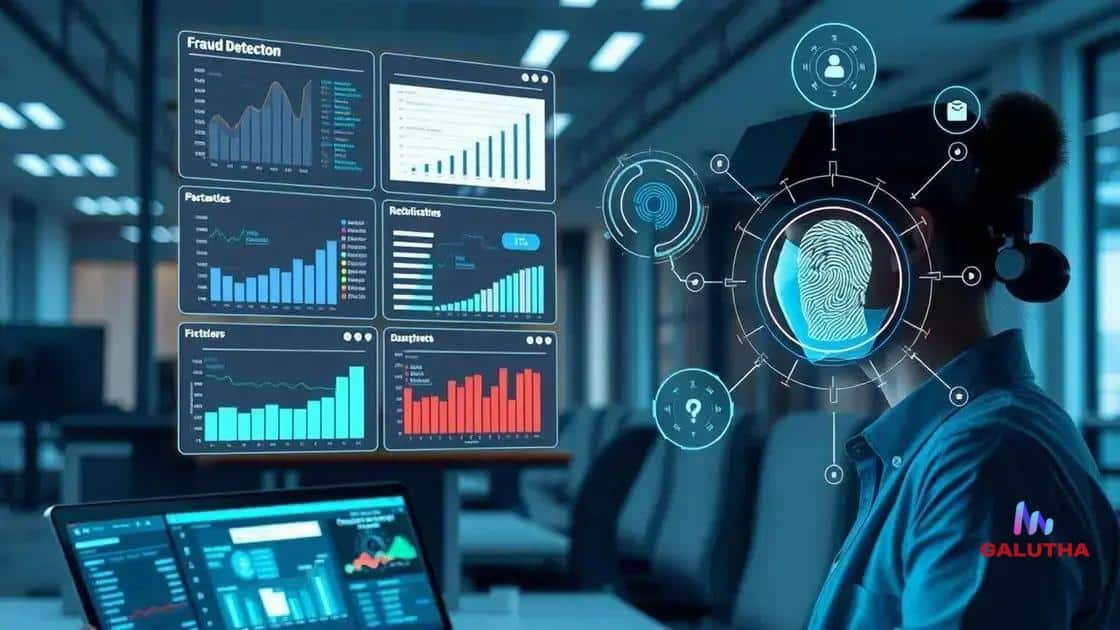Federal benefit fraud detection tools you should know
Federal benefit fraud detection tools utilize advanced technologies like AI and data analytics to identify fraudulent activities, ensuring programs remain secure and efficient in delivering benefits to those in need.
Federal benefit fraud detection tools play a crucial role in safeguarding taxpayers’ money. These tools not only enhance efficiency but also help identify fraudulent activities before they escalate. Are you curious about how they work? Let’s delve into this important topic.
Understanding federal benefit fraud
Understanding federal benefit fraud is vital for protecting public funds and ensuring that benefits reach those who truly need them. This type of fraud can take many forms, affecting various programs designed to assist citizens.
What is federal benefit fraud?
Federal benefit fraud occurs when individuals intentionally misrepresent information to gain benefits they are not entitled to. This can include falsifying income, failing to report changes in circumstances, or using someone else’s identity. Such actions undermine the integrity of essential programs.
Types of federal benefit fraud
- Income misrepresentation: Claiming a lower income than actual.
- Identity theft: Using another person’s information to apply for benefits.
- Failure to report: Not reporting changes in household status.
Fraud can affect multiple federal programs, including Social Security, Medicaid, and unemployment benefits. When individuals engage in fraudulent behavior, it diminishes the resources available for those who genuinely qualify. Moreover, this misuse can lead to severe consequences, including criminal charges.
Detecting federal benefit fraud is critical. Agencies utilize various tools and technologies to monitor claims and identify discrepancies. For instance, advanced data analytics can reveal patterns that suggest fraudulent activities. Additionally, public awareness campaigns help educate individuals about the importance of honest reporting.
In conclusion, grasping the nature of federal benefit fraud helps citizens recognize its impact and the importance of keeping federal programs available for everyone who needs them.
Key technologies in fraud detection tools

Key technologies in fraud detection tools offer innovative solutions to combat federal benefit fraud. Understanding these technologies helps agencies utilize the best methods for identifying fraudulent activities.
Data Analytics and Machine Learning
Data analytics plays a crucial role in detecting fraud. By analyzing patterns in large datasets, agencies can pinpoint unusual activities. Machine learning algorithms enhance this process, learning from past fraudulent cases to improve detection accuracy.
- Identifying patterns: Algorithms look for anomalies in claim submissions.
- Predictive modeling: Predicting future fraud risks based on historical data.
- Automation: Streamlining the review process of applications.
As technology advances, the need for robust systems becomes more critical. Automated systems decrease the time needed for investigation. They can flag suspicious claims quickly, allowing agents to focus on the most challenging cases.
Biometric Verification
Another significant technology is biometric verification. This method ensures that individuals receiving benefits are who they claim to be. By using fingerprints, facial recognition, or voiceprint technology, agencies can prevent identity theft.
Biometric data adds an extra layer of security, making it much harder for fraudsters to manipulate the system. Furthermore, as more people become accustomed to biometric checks, their implementation becomes smoother and more accepted.
Integrating these technologies in a cohesive approach is essential. Fraud detection tools must adapt to the evolving landscape of fraud tactics. As technology improves, so do the methods employed by those looking to exploit systems.
Best practices for using detection tools
Implementing the best practices for using detection tools in identifying federal benefit fraud is crucial for maximizing their effectiveness. By adopting specific strategies, agencies can enhance their ability to combat fraud.
Regular Training and Updates
One of the best practices is to ensure that staff receives regular training on the latest technologies and techniques. Knowledgeable employees can better understand how to utilize detection tools effectively. Keeping them updated about new fraud trends is equally important.
- Ongoing education: Programs should include hands-on training sessions.
- Updates on fraud tactics: Regularly share new strategies implemented by fraudsters.
- Feedback sessions: Encourage sharing challenges faced in using the tools.
By fostering an environment of continuous learning, agencies empower their staff to become adept at spotting fraudulent activities.
Data Integrity and Accuracy
Another key point is maintaining data integrity. Accurate data is vital for the success of any fraud detection tool. Regular audits and checks on data entries can reduce errors. High-quality data ensures that these tools function at their best.
Using reliable data sources is essential. Automated data input can help minimize human error. Additionally, verifying information from different sources enhances the credibility of the claims being processed.
Collaboration between departments serves as a powerful way to share insights and streamline processes. When teams work together, the exchange of information helps in identifying patterns that might indicate fraud. Collaborative efforts make the use of detection tools more effective.
Agencies should also implement a responsive feedback system to address any issues promptly. This approach ensures that the tools used remain relevant and effective in the ever-evolving landscape of fraud.
Impact of fraud on federal programs
The impact of fraud on federal programs is significant and far-reaching. Fraud not only affects the financial health of these programs but also undermines public trust.
Financial Consequences
When fraud occurs, the immediate effect is a financial drain on federal resources. Programs designed to support low-income families, the elderly, and the unemployed can suffer. This misuse can lead to budget shortfalls that compromise the quality of services provided.
- Increased costs: Resources must be redirected to investigate and combat fraud.
- Bureaucratic delays: Investigations can slow down service delivery to legitimate beneficiaries.
- Reallocation of funds: Money lost to fraud often means less support for those in need.
These financial impacts create a ripple effect. As funds diminish, the ability to provide essential services decreases, which can worsen the conditions of vulnerable populations.
Loss of Public Confidence
The effect of fraud goes beyond numbers—it affects how the public perceives government programs. When fraud cases make headlines, it raises questions about the integrity of these programs. Citizens may begin to doubt their effectiveness or their ability to deliver support fairly.
Restoring public confidence requires transparency and accountability. Agencies must demonstrate their commitment to fighting fraud actively. Implementing effective fraud detection tools enhances public trust and signals a strong stance against fraud.
The consequences of fraud extend into policy-making as well. As fraud becomes more prevalent, legislators may feel pressured to introduce stricter regulations, which could hinder access for legitimate beneficiaries. Striking the right balance between security and accessibility is crucial.
Future trends in fraud detection
The future trends in fraud detection are shaping the way agencies combat federal benefit fraud. As technology advances, so do the methods used to identify and prevent fraudulent activities.
Increased Use of Artificial Intelligence
One major trend is the increased use of artificial intelligence (AI) in detecting fraud. AI algorithms can analyze vast amounts of data quickly and accurately. This allows agencies to spot unusual patterns that may indicate fraudulent behavior. Machine learning, a subset of AI, will continue to evolve, learning from historical fraud cases to improve detection strategies.
- Real-time analysis: AI can process data instantly, leading to quicker responses.
- Adaptive learning: Systems can adapt to new fraud tactics as they emerge.
- Enhanced accuracy: Reducing false positives and negatives in fraud detection.
As AI continues to grow, agencies must ensure that their teams are trained to work alongside these advanced technologies.
Integration of Blockchain Technology
Another promising trend is the integration of blockchain technology in fraud detection. Blockchain provides a transparent and secure way to record transactions. This makes it more difficult for fraudsters to manipulate data.
Benefits of blockchain in fraud detection include:
- Immutable records: Once a transaction is recorded, it cannot be changed.
- Increased transparency: All parties can access the same data, ensuring consistency.
- Decentralized verification: Reducing the risk of single points of failure.
As more organizations adopt blockchain, its potential in preventing fraud becomes more apparent.
Beyond these technologies, there will also be an emphasis on collaborative approaches to fraud detection. Agencies will increasingly work together, sharing insights and data to enhance their defenses against fraud. This collaboration can lead to more comprehensive solutions that benefit everyone.
FAQ – Frequently Asked Questions about Federal Benefit Fraud Detection
What are federal benefit fraud detection tools?
Federal benefit fraud detection tools are technologies and methodologies used to identify and prevent fraudulent activities in federal programs.
How does artificial intelligence improve fraud detection?
Artificial intelligence enhances fraud detection by analyzing large datasets quickly, identifying unusual patterns, and adapting to new tactics through machine learning.
Why is data integrity important in fighting fraud?
Data integrity ensures that the information used for detection is accurate, reducing errors and improving the reliability of fraud detection outcomes.
What role does collaboration play in fraud detection?
Collaboration allows various agencies to share insights and data, leading to more comprehensive strategies to combat fraud effectively.





